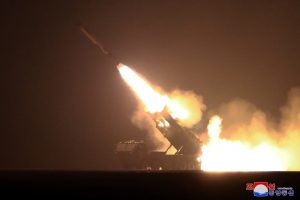North Korea Launches Four “Hwasal-2” LACMs to Show Strong Deterrence and Rapid Response

On February 24, North Korean press reported on a “strategic cruise missile launching drill” the previous day involving “four ‘Hwasal-2’ strategic cruise missiles.” This is the first time North Korea has provided a name for the land-attack cruise missile (LACM) system. North Korea has now reported a total of 12 LACM launches: four of the presumed Hwasal-1 and eight of the Hwasal-2, which apparently has an updated propulsion system and longer range.
The statement’s reference to a “strategic cruise missile unit” adds to previous suggestions that the missile is already operationally deployed. Although the Democratic People’s Republic of Korea (DPRK or North Korea) regularly refers to the LACM as a “strategic missile,” it often associates the system with “tactical nuclear weapons” and has also suggested that some will carry conventional warheads.
This LACM drill is just the latest of Pyongyang’s efforts to demonstrate a strong and credible deterrent, especially amid ongoing US-ROK joint military exercises. It also highlights the LACM’s “rapid response posture,” underscoring a key theme in recent missile launches. LACMs will almost certainly augment rather than supplant North Korea’s longstanding and extensive ballistic missile force, offering further diversity, flexibility and numbers—all important improvements to the country’s conventional warfighting capabilities as well.
Information to Date
The drill, reportedly conducted by “a relevant sub-unit of a strategic cruise missile unit of the Korean People’s Army in the eastern region,” was intended to show “the reliability of the weapon system” and test “the rapid response posture of strategic cruise missile units that constitute one of major forces of the DPRK nuclear deterrent.” According to the statement, the four missiles “precisely hit the preset target on the East Sea of Korea after traveling the 2,000-km-long elliptical and eight-shaped flight orbits for 10,208s to 10,224s [170 minutes].” The statement concluded by claiming “the drill clearly demonstrated once again the war posture of the DPRK nuclear combat force bolstering up in every way its deadly nuclear counterattack capability against the hostile forces.” An associated photo showed a LACM boosted from a five-tube road-mobile launcher.
Analysis
South Korea and Japan apparently did not detect the missiles. This is not surprising given the LACMs’ small size, low altitude and flight location. It also demonstrates the challenges cruise missiles pose for allied air defenses.
The LACM seen in the photo appears to be the modified missile first displayed in October 2021 and flight tested in January 2022. This is the first time North Korea has provided a name for the LACM system, and the use of “Hwasal-2” suggests that the original version of the LACM revealed in September 2021 is the “Hwasal-1.”
North Korea has now reported a total of 12 LACM launches: four of the presumed Hwasal-1 (two single launches in September 2021 and two launches, apparently of that version, in November 2022) and eight Hwasal-2s (dual launches in January and October 2022, and the quad launch in February 2023). The reported 2,000-km range of the October 2022 and February 2023 launches is 200 km more than in January 2022, further suggesting that the modified version has an updated propulsion system and longer range than the 1,500-km Hwasal-1.
The reference in this month’s statement to a “strategic cruise missile unit” adds to previous North Korean suggestions that the LACM is operationally deployed, including the display during the February 8, 2023 military parade of six of the same type of launcher seen in the latest photo. Although the North regularly refers to the LACM as a “strategic missile,” it often also associates the system with “tactical nuclear weapons”—including at the recent parade. In October 2022, it even referred to “the long-range strategic cruise missiles deployed at the units of the Korean People’s Army for the operation of tactical nukes.” Pyongyang also has suggested that some LACMs will carry conventional warheads.
Implications
The latest LACM drill is another example of North Korea trying to demonstrate a strong and credible deterrent (a “deadly nuclear counterattack capability”), especially amid ongoing US-ROK joint military exercises meant to show the strength of US extended deterrence. While doing so, Pyongyang also is highlighting the LACM’s “rapid response posture,” underscoring a key theme in recent launches of the Hwasong-15 intercontinental ballistic missile (ICBM) and two KN-25 short-range ballistic missiles (aka, “super-heavy” or 600-mm multiple launch rockets). Having apparently completed the development of these weapons systems, North Korean missile launches are increasingly focused on ensuring their operational capabilities and crew proficiency.
That said, we still do not know how many LACMs will be deployed or with what mix of warhead types, and thus whether these new cruise missiles truly are “one of major forces of the DPRK nuclear deterrent,” as North Korea currently claims. We also do not know how accurate the missile is, which is critically important for conventional combat.
LACMs will almost certainly augment rather than supplant Pyongyang’s longstanding and extensive ballistic missile force, which can accomplish just about any mission LACMs can. But LACMs can further diversify and increase the flexibility of the North’s missile force. Low-flying, maneuverable LACMs will further complicate Allied regional air and missile defense efforts and probably prompt additional deployments of US/ROK radars and surface-to-air missiles (SAMs). Adding LACMs also boosts the overall size of North Korea’s missile force—this can be especially useful for conventional warfighting (nuclear force size probably would be limited by warhead availability) and in saturating Allied air and missile defenses.
